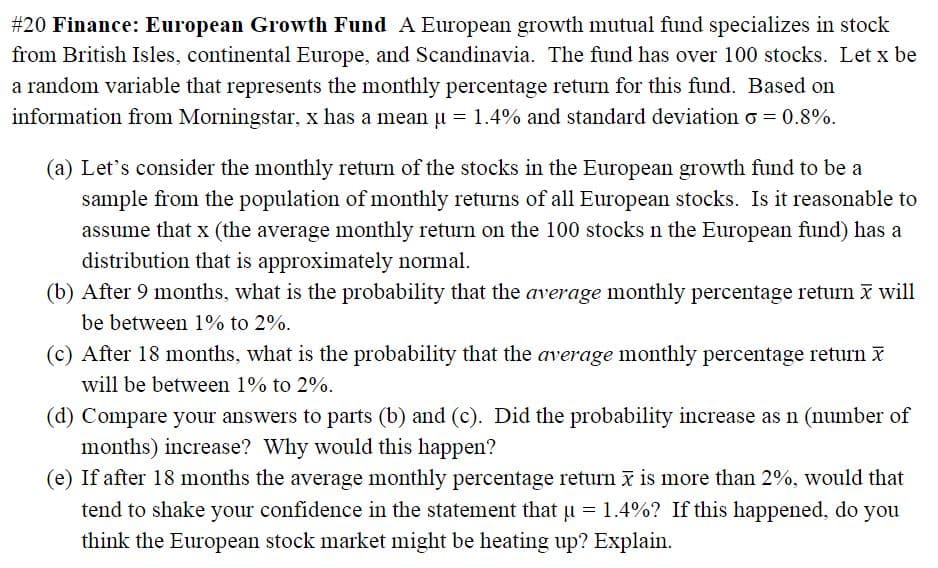#20 Finance: European Growth Fund A European growth mutual fund specializes in stock from British Isles, continental Europe, and Scandinavia. The fund has over 100 stocks. Let x be a random variable that represents the monthly percentage return for this fund. Based on information from Morningstar, x has a mean u = 1.4% and standard deviation o = 0.8%. (a) Let's consider the monthly return of the stocks in the European growth fund to be a sample from the population of monthly returns of all European stocks. Is it reasonable to assume that x (the average monthly return on the 100 stocks n the European fund) has a distribution that is approximately normal. (b) After 9 months, what is the probability that the average monthly percentage return I will be between 1% to 2%. (c) After 18 months, what is the probability that the average monthly percentage return x will be between 1% to 2%. (d) Compare your answers to parts (b) and (c). Did the probability increase as n (number of months) increase? Why would this happen? (e) If after 18 months the average monthly percentage return ī is more than 2%, would that tend to shake your confidence in the statement that u = 1.4%? If this happened, do you think the European stock market might be heating up? Explain.
#20 Finance: European Growth Fund A European growth mutual fund specializes in stock from British Isles, continental Europe, and Scandinavia. The fund has over 100 stocks. Let x be a random variable that represents the monthly percentage return for this fund. Based on information from Morningstar, x has a mean u = 1.4% and standard deviation o = 0.8%. (a) Let's consider the monthly return of the stocks in the European growth fund to be a sample from the population of monthly returns of all European stocks. Is it reasonable to assume that x (the average monthly return on the 100 stocks n the European fund) has a distribution that is approximately normal. (b) After 9 months, what is the probability that the average monthly percentage return I will be between 1% to 2%. (c) After 18 months, what is the probability that the average monthly percentage return x will be between 1% to 2%. (d) Compare your answers to parts (b) and (c). Did the probability increase as n (number of months) increase? Why would this happen? (e) If after 18 months the average monthly percentage return ī is more than 2%, would that tend to shake your confidence in the statement that u = 1.4%? If this happened, do you think the European stock market might be heating up? Explain.
Linear Algebra: A Modern Introduction
4th Edition
ISBN:9781285463247
Author:David Poole
Publisher:David Poole
Chapter3: Matrices
Section3.7: Applications
Problem 44EQ
Related questions
Question
please answer especially D and E ! thank you

Transcribed Image Text:#20 Finance: European Growth Fund A European growth mutual fund specializes in stock
from British Isles, continental Europe, and Scandinavia. The fund has over 100 stocks. Let x be
a random variable that represents the monthly percentage return for this fund. Based on
information from Morningstar, x has a mean u = 1.4% and standard deviation o = 0.8%.
(a) Let's consider the monthly return of the stocks in the European growth fund to be a
sample from the population of monthly returns of all European stocks. Is it reasonable to
assume that x (the average monthly return on the 100 stocks n the European fund) has a
distribution that is approximately normal.
(b) After 9 months, what is the probability that the average monthly percentage return X will
be between 1% to 2%.
(c) After 18 months, what is the probability that the average monthly percentage return x
will be between 1% to 2%.
(d) Compare your answers to parts (b) and (c). Did the probability increase as n (number of
months) increase? Why would this happen?
(e) If after 18 months the average monthly percentage return i is more than 2%, would that
tend to shake your confidence in the statement that u = 1.4%? If this happened, do you
think the European stock market might be heating up? Explain.
Expert Solution
This question has been solved!
Explore an expertly crafted, step-by-step solution for a thorough understanding of key concepts.
This is a popular solution!
Trending now
This is a popular solution!
Step by step
Solved in 2 steps with 2 images

Recommended textbooks for you

Linear Algebra: A Modern Introduction
Algebra
ISBN:
9781285463247
Author:
David Poole
Publisher:
Cengage Learning

Functions and Change: A Modeling Approach to Coll…
Algebra
ISBN:
9781337111348
Author:
Bruce Crauder, Benny Evans, Alan Noell
Publisher:
Cengage Learning

Glencoe Algebra 1, Student Edition, 9780079039897…
Algebra
ISBN:
9780079039897
Author:
Carter
Publisher:
McGraw Hill

Linear Algebra: A Modern Introduction
Algebra
ISBN:
9781285463247
Author:
David Poole
Publisher:
Cengage Learning

Functions and Change: A Modeling Approach to Coll…
Algebra
ISBN:
9781337111348
Author:
Bruce Crauder, Benny Evans, Alan Noell
Publisher:
Cengage Learning

Glencoe Algebra 1, Student Edition, 9780079039897…
Algebra
ISBN:
9780079039897
Author:
Carter
Publisher:
McGraw Hill